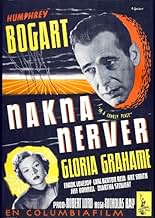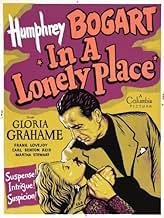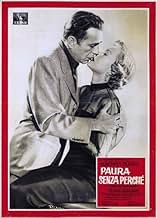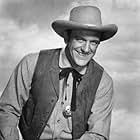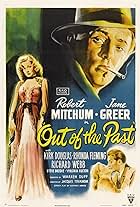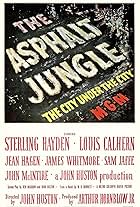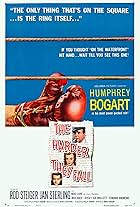A potentially violent screenwriter is a murder suspect until his lovely neighbor clears him. However, she soon starts to have her doubts.A potentially violent screenwriter is a murder suspect until his lovely neighbor clears him. However, she soon starts to have her doubts.A potentially violent screenwriter is a murder suspect until his lovely neighbor clears him. However, she soon starts to have her doubts.
- Awards
- 3 wins total
James Arness
- Young Detective
- (uncredited)
Pat Barton
- Second Hat Check Girl
- (uncredited)
David Bond
- Dr. Richards
- (uncredited)
Hazel Boyne
- Person
- (uncredited)
Laura K. Brooks
- Lady Wanting Matches
- (uncredited)
Storyline
Did you know
- TriviaIn her essay "Humphrey and Bogey", Louise Brooks wrote that more than any other role that Humphrey Bogart played, it was the role of Dixon Steele in this movie that came closest to the real Bogart she knew.
- GoofsAfter leaving the beach driving in his convertible, although Dix is going 70 MPH, neither his nor Laurel's hair is disturbed by the wind.
- Quotes
Dixon Steele: I was born when she kissed me. I died when she left me. I lived a few weeks while she loved me.
- ConnectionsEdited into Dead Men Don't Wear Plaid (1982)
Featured review
Bogart reportedly thought the movie a failure. Certainly box-office results were dismal and Bogie's production company, Santana, lost a bundle. Hard to believe anyone thought this disturbing film with its downbeat ending would actually make money. Bogart's Dix Steel (that name should have been reconsidered) is a borderline psychopath, a Jekyll and Hyde who can boil over in an instant. He's a walking volcano whose sensitive side simply cannot contain the inner turmoil. In that day, few Hollywood egos had the assurance to take on such an unflattering role, especially the shadowy later scenes where his creviced face approaches the grotesque. It's a fine and daring performance, and the last, I believe, where Bogart plays even a semi- romantic leading man.
Good as Bogart is, this is a Gloria Graham showcase. Her droopy upper lip and pouty face never quite fit the Hollywood mold, and by decade's end, she was gone. Here, however, she's near perfect as the jaded starlet, with a questionable background and just a hint of 50's kink. Her Laurel Gray emerges as a vulnerable, yet street-wise toughie, drawing the eager Steel into a torrid affair, (only hinted at because of the production code of the day). But as his character unravels, so must hers, which it does in beautifully understated stages. Watch her quietly desperate reaction to Steel following the assault on the motorist, or her barely controlled panic at film's end. It's an award-level performance, all the better for refusing to go over the top, despite the many opportunities. Small wonder she remains an enduring noir favorite.
The mystery angle may be a clever plot device, but it's director Nicholas Ray's powerful vision that makes the film gel. A poet of post-war alienation, he's the perfect overseer of such fare, combining the elements into a grimly compelling view of human estrangement and isolation. Perhaps no director other than Elia Kazan could work with a cast as effectively as Ray. Notice how distinctively each of the supporting players is drawn, from the Shakespearean drunk to the hard-bitten maid to the lounge lizards at Romanoff's. Only the cops in routine roles seem to fade into the background. Underrated in many of Ray's best films is the scoring, and this film is no exception. George Antheil's compositions are simple yet expertly conceived, highlighting the scenes without rivaling them and lending just the right emotional tone. My one complaint: I've never understood why an industry so close to the beach couldn't film at the beach, or at least couldn't have come up with a better process shot than the one here.
Nonetheless Bogart was wrong. The film is anything but a failure. Coming from an era of happy endings, Dix and Laurel remain star-crossed lovers, doomed by their own sophistication and inner demons, for which there appears no cure. Expecting uplift, audiences of the day may not have responded, but viewers during the years between have, recognizing In a Lonely Place for the noir classic it is. This quietly disturbing portrayal of one man's inability to cope continues to resonate beyond the confines of today's slam-bang world. So whatever you do, don't miss it.
Good as Bogart is, this is a Gloria Graham showcase. Her droopy upper lip and pouty face never quite fit the Hollywood mold, and by decade's end, she was gone. Here, however, she's near perfect as the jaded starlet, with a questionable background and just a hint of 50's kink. Her Laurel Gray emerges as a vulnerable, yet street-wise toughie, drawing the eager Steel into a torrid affair, (only hinted at because of the production code of the day). But as his character unravels, so must hers, which it does in beautifully understated stages. Watch her quietly desperate reaction to Steel following the assault on the motorist, or her barely controlled panic at film's end. It's an award-level performance, all the better for refusing to go over the top, despite the many opportunities. Small wonder she remains an enduring noir favorite.
The mystery angle may be a clever plot device, but it's director Nicholas Ray's powerful vision that makes the film gel. A poet of post-war alienation, he's the perfect overseer of such fare, combining the elements into a grimly compelling view of human estrangement and isolation. Perhaps no director other than Elia Kazan could work with a cast as effectively as Ray. Notice how distinctively each of the supporting players is drawn, from the Shakespearean drunk to the hard-bitten maid to the lounge lizards at Romanoff's. Only the cops in routine roles seem to fade into the background. Underrated in many of Ray's best films is the scoring, and this film is no exception. George Antheil's compositions are simple yet expertly conceived, highlighting the scenes without rivaling them and lending just the right emotional tone. My one complaint: I've never understood why an industry so close to the beach couldn't film at the beach, or at least couldn't have come up with a better process shot than the one here.
Nonetheless Bogart was wrong. The film is anything but a failure. Coming from an era of happy endings, Dix and Laurel remain star-crossed lovers, doomed by their own sophistication and inner demons, for which there appears no cure. Expecting uplift, audiences of the day may not have responded, but viewers during the years between have, recognizing In a Lonely Place for the noir classic it is. This quietly disturbing portrayal of one man's inability to cope continues to resonate beyond the confines of today's slam-bang world. So whatever you do, don't miss it.
- dougdoepke
- Oct 3, 2013
- Permalink
- How long is In a Lonely Place?Powered by Alexa
Details
- Release date
- Country of origin
- Language
- Also known as
- La muerte en un beso
- Filming locations
- City Hall - 455 N. Rexford Drive, Beverly Hills, California, USA(exteriors: Dixon leaves police headquarters after first questioning; seen later from post office across street)
- Production company
- See more company credits at IMDbPro
Box office
- Gross worldwide
- $22,276
- Runtime1 hour 34 minutes
- Color
- Aspect ratio
- 1.33 : 1
Contribute to this page
Suggest an edit or add missing content




